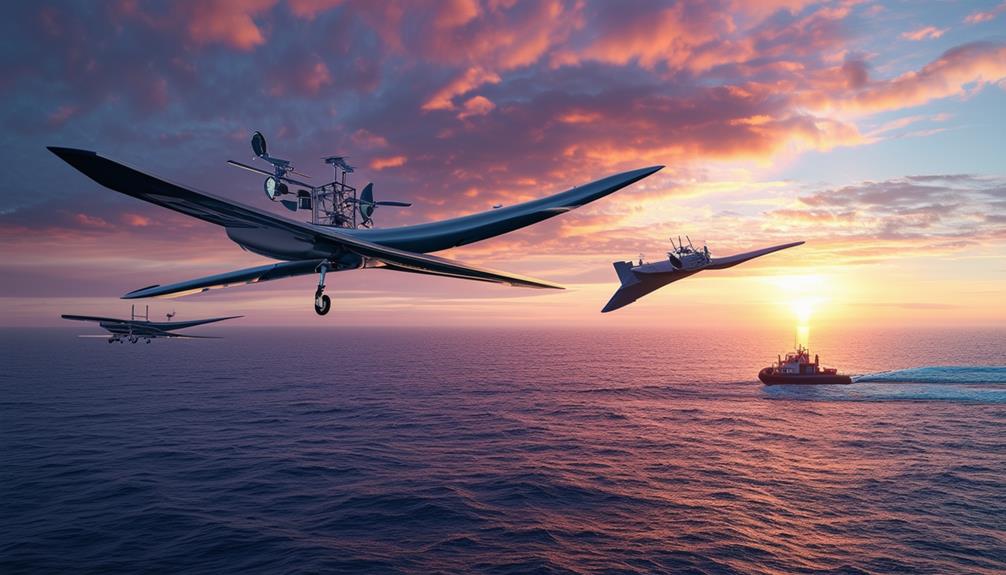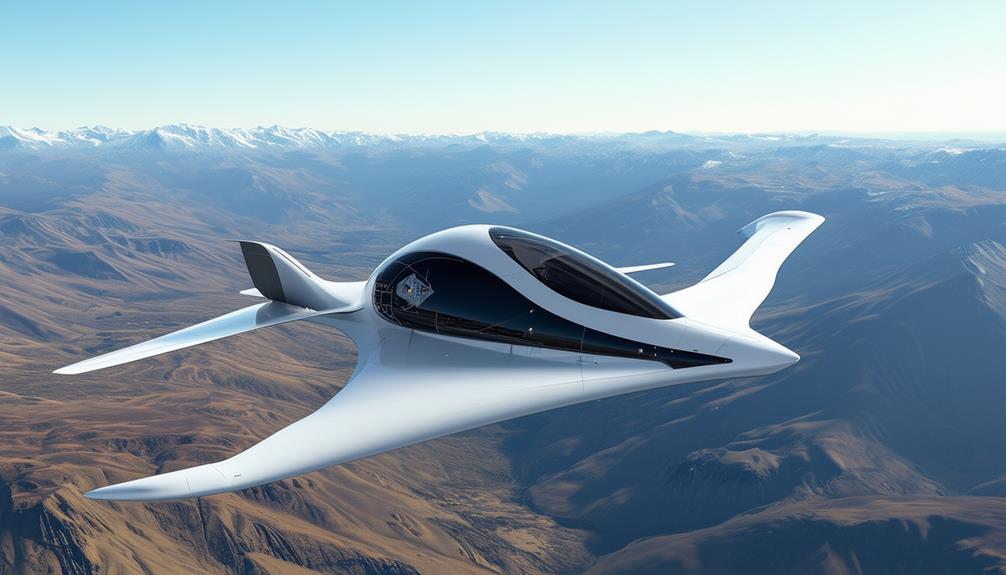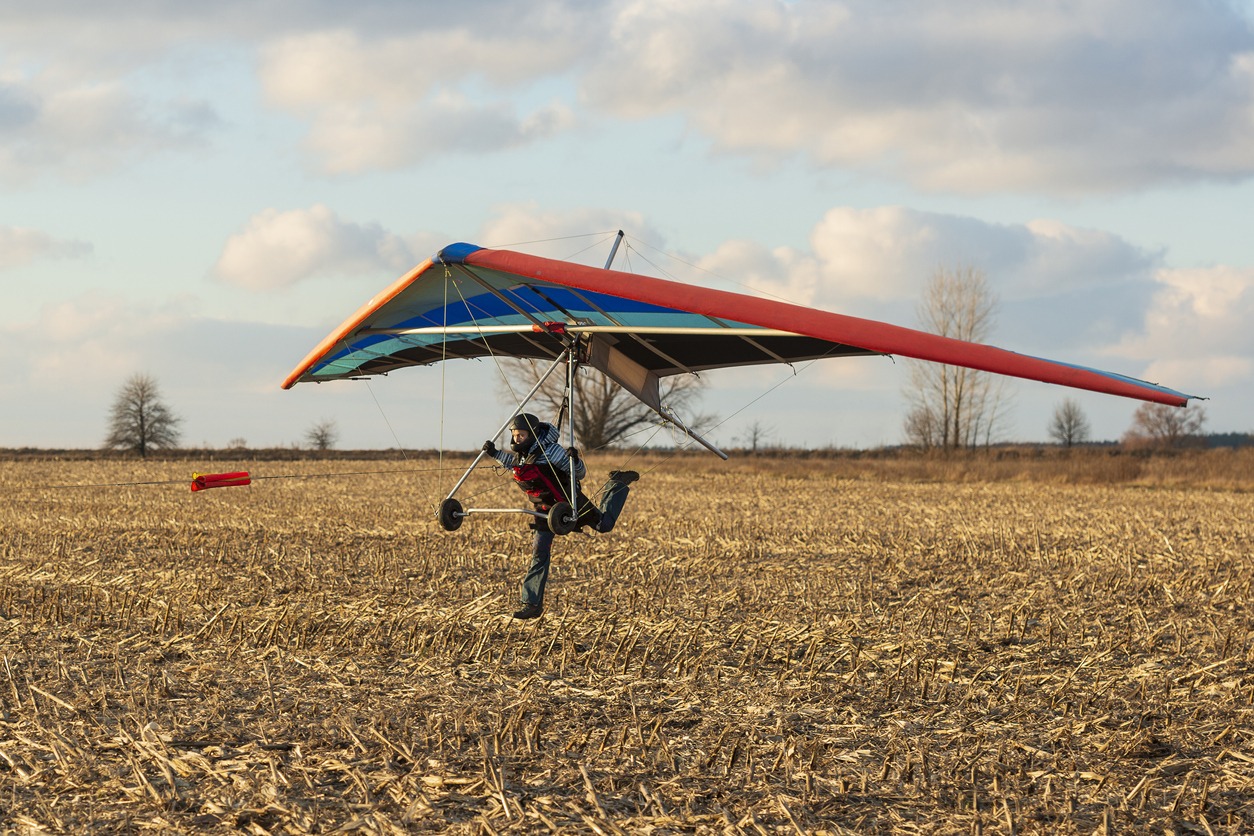How Gliders Are Used in Scientific Research

When you think of gliders, you might picture silent, soaring aircraft gracefully navigating the sky. However, their role in scientific research extends far beyond mere elegance.
These engineless wonders are crucial for gathering data in atmospheric and oceanographic studies. By harnessing natural air currents, gliders like the Perlan 2 can ascend to altitudes with low air density, providing invaluable insights into climate conditions and greenhouse gases.
In oceanography, they autonomously track marine life and map habitats. Curious about the specific techniques and advancements enabling this?
Let's explore how gliders are transforming environmental science.
Overview of Gliders

Gliders are engineless aircraft designed for scientific research, capable of reaching altitudes where air density is just 2% of sea level. These silent, piloted aircraft, such as the renowned Perlan 2, are built to soar to great heights, often aiming to break altitude records. Instead of relying on engines, gliders harness natural air currents, making them ideal for atmospheric studies.
While underwater vehicles explore the ocean depths, gliders navigate the skies, offering a unique perspective on our planet's climate and atmospheric conditions. Their engine-free design allows for precise circling and steering, enabling researchers to gather critical data effectively.
Equipped with a range of scientific instruments, gliders collect valuable information on climate patterns and atmospheric phenomena. Their design and functionality make them indispensable tools in advancing scientific knowledge about our environment.
When considering cutting-edge scientific research, the role of these remarkable engineless aircraft in expanding our understanding of the world is significant and noteworthy.
Data Collection Methods
Using a suite of advanced scientific instruments, these engineless aircraft gather critical data on climate and atmospheric conditions. When employing gliders for research, scientists rely on a platform capable of measuring a wide range of atmospheric components essential for climate modeling. These instruments, attached to the glider, measure levels of aerosols, greenhouse gases, ozone, methane, and water vapor.
By maneuvering and circling, gliders can provide direct observations of polar stratospheric clouds, offering invaluable insights into the stratosphere.
Key measurements include:
- Aerosols: Tiny particles that influence cloud formation and atmospheric chemistry.
- Greenhouse gases: Major contributors to climate change, such as CO2 and methane.
- Ozone: Crucial for blocking harmful UV radiation, yet variable in the stratosphere.
- Water vapor: Affects weather patterns and climate dynamics.
The Perlan 2 glider, for instance, aims to break the world altitude record, further advancing our understanding of climate science with its data collection capabilities. By studying stratospheric mountain waves and their interactions with polar meteorology, gliders offer a unique perspective that other methods can't match.
All rights are reserved for the pioneering techniques and data these gliders provide.
Oceanographic Research
Using gliders for oceanographic research enables autonomous data collection with real-time insights. These vehicles excel in habitat mapping, allowing for the study of intricate marine environments.
Their capacity for long-term environmental monitoring aids in tracking ocean changes over extended periods, providing valuable data for ongoing research.
Autonomous Data Collection
Autonomous gliders revolutionize oceanographic research by independently collecting critical data on water properties, currents, and marine life. These underwater robots offer a cost-effective and efficient solution for scientists, operating without the need for constant human oversight.
Deploying a glider allows for data collection over extended periods and across vast areas, making them particularly valuable for long-term studies and monitoring remote regions. Equipped with advanced sensors, gliders measure:
- Water temperature and salinity
- Chlorophyll levels, indicating phytoplankton presence
- Dissolved oxygen, vital for marine ecosystems
- Acoustic signals, aiding in the study of marine mammals
Utilizing gliders significantly reduces the costs associated with manned expeditions and minimizes the environmental footprint of research vessels. These autonomous vehicles can dive to great depths and surface repeatedly, transmitting real-time data back to the lab. This continuous data stream is crucial for understanding ocean dynamics and predicting climate change impacts.
Habitat Mapping Techniques
Mapping ocean habitats with gliders offers researchers precise and comprehensive insights into marine environments. These autonomous vehicles are equipped with an array of sensors to map habitats, measure water properties, and track marine life movements. By covering extensive areas with high resolution, gliders provide invaluable data on critical parameters such as temperature, salinity, chlorophyll levels, and oxygen concentrations, essential for understanding the complexities of marine ecosystems.
Gliders are both cost-effective and efficient, making them an ideal tool for habitat mapping. They can survey diverse habitats, from coastal regions to the deep sea, thereby contributing significantly to conservation efforts and the sustainable management of marine resources. The data collected aids scientists in creating detailed maps that identify critical habitats, monitor biodiversity, and assess the impacts of environmental changes.
Here's a quick overview of how gliders contribute to habitat mapping:
| Parameter | Measured Data | Impact on Habitat Mapping |
|---|---|---|
| Temperature | Heat distribution | Identifies thermal habitats and currents |
| Salinity | Salt concentration | Determines water mass and marine life zones |
| Chlorophyll | Phytoplankton abundance | Tracks primary productivity |
| Oxygen | Oxygen concentrations | Assesses the health of marine environments |
| Coverage | Large area mapping | Provides extensive and comprehensive habitat data |
Long-term Environmental Monitoring
Leveraging advanced technology similar to that used in habitat mapping, gliders are essential for long-term environmental monitoring in oceanographic research. These autonomous vehicles collect data over extended periods, providing scientists with continuous, valuable information about ocean conditions. Equipped with various sensors, gliders measure key parameters such as temperature, salinity, and oxygen levels—crucial for understanding ocean dynamics.
Deploying gliders enables insights into the impacts of climate change and allows for detailed studies of marine ecosystems. They monitor fluctuations in ocean temperatures, track changes in salinity, and measure oxygen levels, all of which are necessary for assessing marine life health and oceanic processes.
Here's how gliders enhance long-term environmental monitoring:
- Continuous Data Collection: Gliders provide ongoing data without requiring constant human intervention, unlike traditional methods.
- Autonomous Operation: They navigate the ocean autonomously, covering vast areas over extended periods.
- Diverse Sensor Suite: Outfitted with multiple sensors, they can simultaneously measure a range of environmental parameters.
- Sustainable Management: The data collected supports the sustainable management of marine resources, helping to maintain healthy ecosystems.
Climate Change Studies
Gliders equipped with advanced instruments play a crucial role in collecting precise data for climate change studies. These gliders measure aerosols, greenhouse gases, ozone, methane, and water vapor, all essential components for understanding our changing climate. By gathering detailed data, gliders help refine climate models, making predictions more accurate and reducing uncertainties.
One significant advantage of gliders is their ability to maneuver and circle, enabling them to provide direct observations of polar stratospheric clouds. These clouds are critical for climate studies due to their role in ozone depletion. The Perlan 2 glider, in particular, is pushing boundaries by aiming to break the world altitude record for gliding. Achieving this will yield valuable data for climate science, especially in the stratosphere, where traditional aircraft have limited access.
Additionally, gliders studying stratospheric mountain waves offer insights into how these waves interact with polar meteorology. This interaction is vital for understanding climate change in polar regions.
Marine Biology Applications
Autonomous gliders can precisely track marine species and monitor ocean chemistry. These vehicles collect critical data on water temperature, salinity, and oxygen levels, which enhances the understanding of marine ecosystems.
Analyzing these metrics allows for a better assessment of the impacts of climate change and human activities on ocean life.
Tracking Marine Species
In marine biology, autonomous gliders are crucial for tracking the movements and behaviors of marine species. These devices navigate the ocean, collecting essential data on habitats, migration patterns, and population dynamics. By using gliders, researchers can gain a deeper understanding of marine ecosystems and enhance conservation efforts.
Gliders are particularly effective because they can survey large areas over extended periods without disturbing marine life. The data collected is vital for preserving biodiversity and maintaining ecosystem health. This information helps make informed decisions about marine conservation strategies.
Here's how gliders contribute to tracking marine species:
- Monitor Migration Patterns: Track seasonal movements and breeding behaviors of marine animals.
- Analyze Habitat Use: Identify crucial habitats for different species at various life stages.
- Assess Population Dynamics: Gather data on population sizes and health, essential for conservation planning.
- Detect Environmental Changes: Observe how marine species respond to environmental changes, such as temperature shifts or pollution.
Monitoring Ocean Chemistry
Autonomous gliders equipped with scientific instruments continuously monitor ocean chemistry, providing crucial data for understanding marine ecosystems. These gliders collect real-time data on ocean health, aiding in the study of marine ecosystems, biodiversity, and the impacts of climate change. They offer insights into key parameters such as ocean acidification, nutrient levels, and pollutant concentrations.
By gathering data continuously, gliders enable the tracking of changes over time and the detection of patterns that might otherwise go unnoticed. This real-time data is essential for understanding how various factors affect marine life and for making informed conservation and management decisions. With the help of gliders, researchers can better grasp the complexities of marine biology and take proactive steps to protect our oceans.
| Parameter | Importance |
|---|---|
| Ocean Acidification | Affects shellfish and coral health |
| Nutrient Levels | Influences algal blooms and fish stocks |
| Pollutant Concentrations | Impacts overall marine ecosystem health |
Through continuous monitoring, gliders play a pivotal role in marine research. They enable researchers to understand ongoing changes in ocean chemistry, thereby assisting in devising strategies to mitigate negative impacts. Leveraging the data collected from these gliders contributes to more effective marine conservation and management efforts.
Technological Advancements
Modern scientific research frequently leverages advanced gliders, including Autonomous Underwater Vehicles (AUVs) and Remotely Operated Vehicles (ROVs), to explore and gather data from the ocean. These gliders can operate autonomously or be controlled remotely, enabling scientists to collect critical information on ocean conditions and ecosystems without needing to be physically present.
Envision a fleet of these gliders, each outfitted with state-of-the-art sensors and instruments, gathering valuable data for climate, aerospace, and stratospheric research. For instance, the Perlan 2 glider aims to break altitude records while studying stratospheric mountain waves, contributing to more accurate climate models. Similarly, Wave Gliders are engineered to endure severe weather conditions, ensuring continuous data collection for extended scientific experiments.
Key technological advancements in contemporary research gliders include:
- Autonomous Operation: AUVs and ROVs navigate and gather data independently, minimizing the need for human intervention.
- Advanced Sensors: These gliders are equipped with diverse sensors to measure temperature, salinity, currents, and detect specific chemical compounds.
- Durability: Wave Gliders are designed to withstand harsh sea conditions, ensuring long-term, reliable data collection.
- High Altitude Capabilities: Gliders like the Perlan 2 reach the stratosphere, collecting essential data for understanding atmospheric phenomena.
These advancements render gliders indispensable tools in modern scientific research, enhancing our understanding of various environmental and atmospheric conditions.
Future Prospects

Looking ahead, gliders are set to revolutionize scientific exploration by reaching unprecedented altitudes and providing critical data for climate and aerospace research.
Picture a glider soaring to heights where air density is just 2% of sea level. This isn't a distant vision; it's the mission of the Perlan 2 glider. Equipped with advanced scientific instruments, the Perlan 2 aims to enhance climate models by gathering detailed atmospheric data.
Future iterations of these gliders are expected to reach altitudes above 30,000 meters. At such elevations, they can simulate flight conditions on Mars, offering researchers essential insights for future missions. Unlike drones, gliders can function as long-term scientific platforms, particularly in challenging flight conditions.
Piloted gliders hold unique value in this context. They can explore altitudes higher than any other piloted aircraft, significantly contributing to scientific progress. The presence of a human pilot allows for real-time decision-making and adaptability, enhancing the effectiveness of these missions.
Conclusion
Gliders are revolutionizing scientific research by leveraging natural air and water currents to operate silently and efficiently. These innovative tools provide invaluable data on climate, oceanography, and marine biology.
With continuous technological advancements, gliders are set to become even more crucial in our efforts to understand and protect the environment. Embrace this cutting-edge technology and witness its impact on the future of scientific exploration.




